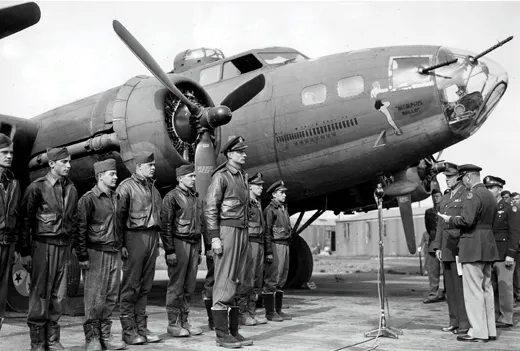WWII: A Reader’s Guide to the Air War
Our pick of the best books and memoirs on World War II aviation.
The literature on the air war during World War II is voluminous, and one could assemble any number of reading lists depending on the audience and the taste of the recommender. Most readers, though, should find the following titles of interest:
The war opened in 1939 with the German Blitzkrieg on Poland, followed by the “Sitzkrieg” during the fall and winter of 1939-1940, then the assault on Scandinavia, France, the Low Countries, and England. Among the memoirs that cover this period are Antoine de Saint-Exupéry’s bittersweet Flight to Arras and Paul Richey’s harrowing Fighter Pilot, which describe the fall of France from the perspective of a French aviator/philosopher and a young Royal Air Force pilot thrown into the optimistically named Advanced Air Striking Force in May-June 1940.
The Battle of Britain has been the subject of innumerable works, but for vividness and a sense of the overall flow of the battle, Derek Wood and Derek Dempster’s The Narrow Margin is excellent for the British side, while Adolf Galland’s The First and the Last offers an intriguing look at the battle from the perspective of a German fighter pilot who later became a senior fighter commander.
As the Battle of Britain wound down, the Royal Air Force and Fleet Air Arm found themselves fighting a war very different from what prewar planners had foreseen. John Terraine’s A Time for Courage (published in the United Kingdom as The Right of the Line) is an extraordinary—and moving—history of the RAF in the European air war. Many pilot memoirs exist of the war, but several stand out: J.E. Johnson, Wing Leader, about an RAF fighter pilot from the time of the Battle of Britain through the fall of Berlin; Charles Lamb, To War in a Stringbag, the memoir of a Royal Navy torpedo bomber pilot; and Group Captain Basil Embry’s Mission Completed, by one of the most successful bomber pilots of the war. Perhaps the finest of all RAF pilot memoirs is from a Free French pilot who flew with Fighter Command, Pierre Clostermann. His The Big Show is one of the best memoirs from any airman at any time.
As the war unfolded, the role of science and technology became ever more important. R.V. Jones’ The Wizard War (published in the UK as Most Secret War) reads like a thriller: spies, deception, and weapons of mass destruction, all seen through the eyes of Churchill’s chief of scientific intelligence, a man who subsequently influenced the partnership of science and intelligence on both sides of the Atlantic. The air war over Europe and the Pacific was notable for the use of strategic bombing, and four bluntly honest and forthright memoirs from key military commanders are indispensable: Arthur “Bomber” Harris’s Bomber Command, Curtis Lemay’s (with MacKinley Kantor) Mission With Lemay, James H. “Jimmy” Doolittle’s I Could Never Be So Lucky Again, and Henry “Hap” Arnold’s Global Mission.
American fighter pilots distinguished themselves on all fronts during the war, and several memoirs stand out: Edwards Park’s wry Nanette, a whimsical and moving account of a young pilot thrown against the aggressive Zero and Oscar pilots of Imperial Japan in the less-than-stellar P-39 Airacobra; Donald Lopez’ wonderful Into the Teeth of the Tiger, a memoir from a P-40 and P-51 pilot in China who later became deputy director of the National Air and Space Museum; Robert S. Johnson’s Thunderbolt!, a gritty account of the early days of fighter operations by P-47s against the cream of the Luftwaffe; John Foster’s Hell in the Heavens, about a Marine fighter pilot in the Southwest Pacific; and Clarence Anderson’s To Fly and Fight, a Mustang pilot’s memoir of the 1944-1945 European air war.
The development and testing of new airplanes during the war has received too little attention, so test pilot memoirs are particularly welcome. Among the best are Allen Wheeler’s That Nothing Failed Them; Grumman test pilot Corwin “Corky” Meyer’s Corky Meyer’s Flight Journal; German test pilot Hans Werner Lerche’s Luftwaffe Test Pilot (about testing captured Allied aircraft); Me 163 Komet test pilot Wolfgang Spate’s Top Secret Bird; Fleet Air Arm test pilot Eric Brown’s Wings on My Sleeve; and Charles Lindbergh’s The Wartime Journals of Charles A. Lindbergh.
Little has appeared in English from Japanese perspectives on the Pacific Air War, but three gripping memoir/histories are Mitsuo Fuchida, Midway: The Battle That Doomed Japan; Saburo Sakai’s Samurai!, and Jiro Horikoshi’s The Zero Fighter, by that airplane’s designer.
Ernest K. Gann’s Fate is the Hunter relates the little-appreciated air transport side, seen from the perspective of an airline pilot called upon to fly both the North Atlantic and Hump routes in C-47 and C-87 aircraft.
Richard P. Hallion was the Air Force Historian from 1991 to 2002, and is currently the Verville Fellow at the National Air and Space Museum.
